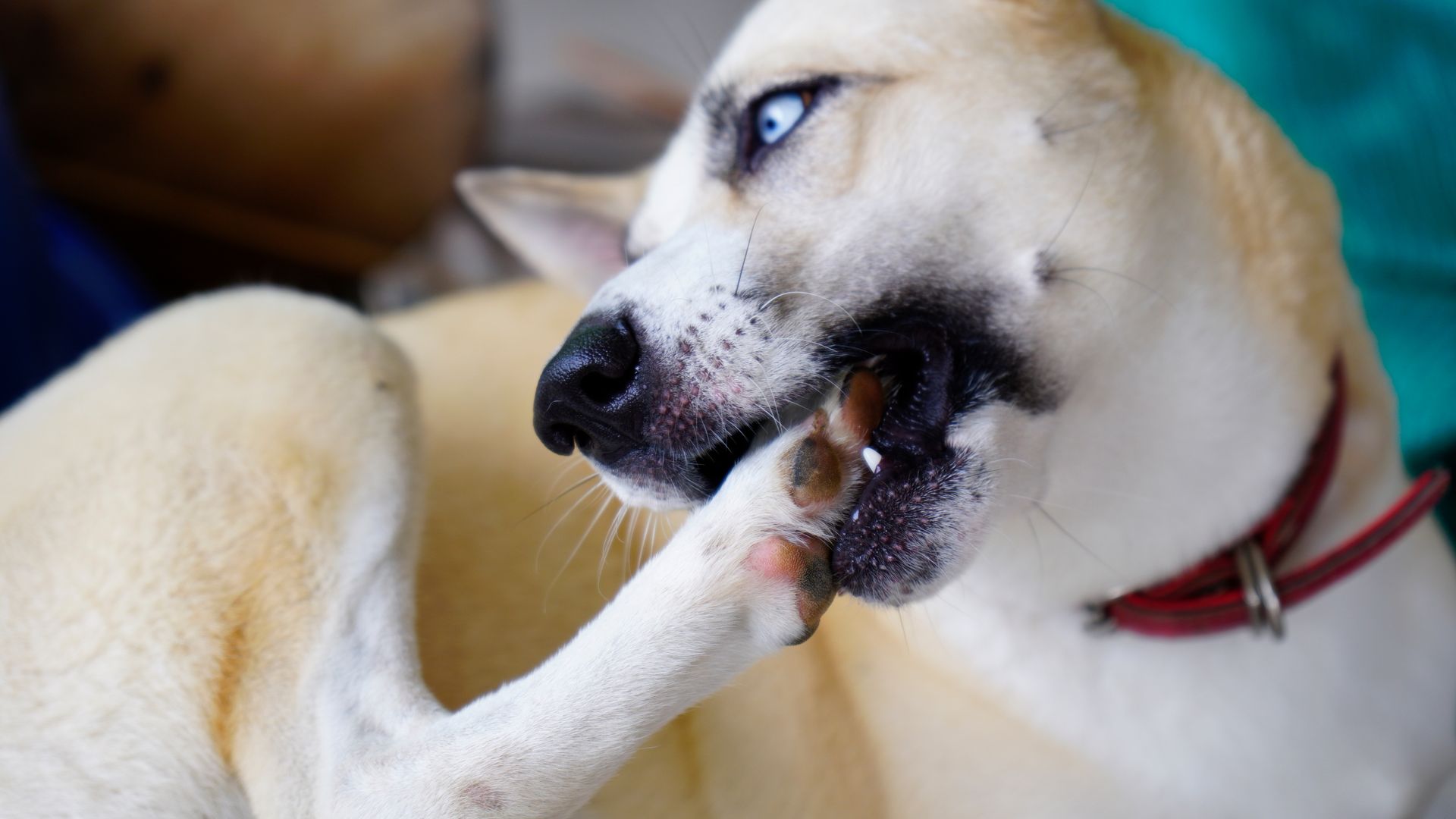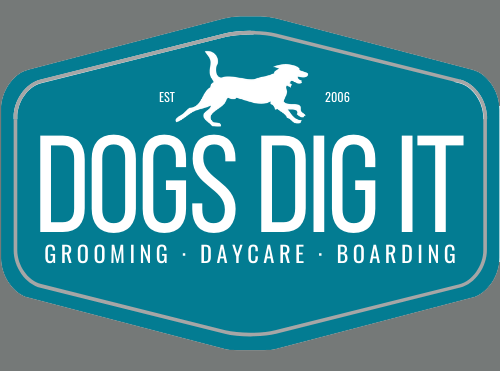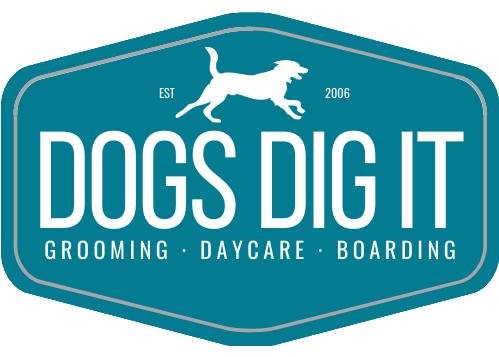EMAIL US TODAY! frontdesk@dogsdigitpdx.com
Top Signs Your Dog Has Allergies

Spring is in the air, and that means the number of seasonal allergens are as well. That’s right: Our pets can suffer the effects of allergies, too.
With the increase in potential environmental allergens, your dog may be experiencing allergies, and here’s what you need to know. Allergies are quite common in dogs of all breeds and backgrounds.

Have you noticed your dog, or puppy, itching, scratching, chewing, or licking themselves excessively? These are all signs that your dog may have allergies. While the allergies experienced by people and dogs can be similar, the signs and symptoms are usually different. Dogs typically don't experience sneezing, runny eyes, and congestion as humans do.
Dog allergy symptoms most commonly affect the skin and ears.
The most common signs that your dog may have allergies, includes itching, scratching, chewing, or licking themselves excessively.
Allergies in dogs are more common than we might think. In fact, according to Pub Med “as many as 60-70% of dogs have some form of allergy.”
Additionally, allergies are one of the top reasons behind veterinary appointments that fall outside routine wellness checks.

There are generally two types of dog allergies, including allergies stemming from the environment and seasonal changes, or food.
The symptoms of food allergies may not be what pet owners expect, making them much more difficult to identify. The most common food allergy symptoms in dogs show up as some type of skin reaction. The severity of skin reaction varies from mild to excessive.
Common areas of the skin where dog allergies appear include:
- Chest
- Armpits
- Belly
- Feet
- Ears
- Eyes
- Mount
- Groin
Symptoms of environmental and seasonal allergies in dogs commonly include scratching and itchy skin, licking (especially licking the paws), and rubbing the face. Other symptoms might include watery eyes, red skin, loss of fur, reoccurring skin and ear infections. Frequent licking of the paws may result in “fur staining” which causes the fur to become brown or reddish. Ear infections are also common as the healthy skin barrier is being broken down due to undiagnosed or untreated allergies.

Similarly, the signs of food allergies may include similar symptoms as environmental and seasonal allergies, and also include GI symptoms, such as an increase or change in bowel habits, abdominal discomfort, and increased salivation.
Types of Allergies Troubling Your Dog
There are several types of allergies in dogs, including:
Flea Allergy: Your dog may be reacting to the protein in flea saliva, but not the actual fleas. A flea allergy does not necessarily mean flea infestation. A dog that has come in contact with a single flea can still have an extensive systemic allergic reaction due to their body’s reaction to just that one flea’s saliva. Itchiness of the lower back, specifically near the base of the tail, is a hallmark sign of flea allergies.
Canine Atopic Dermatitis: Referred to as atopy or atopic dermatitis (AD), is a very common dog allergy. AD is usually an inherited predisposition to develop allergies after exposure to common environmental substances or seasonal allergens in the air, including pollens, grasses, weeds, molds, or fungi. Common signs of AD are itching and inflammation in a dog which often appears under the arms, groin, face and feet.
Canine Atopic Dermatitis: Referred to as atopy or atopic dermatitis (AD), is a very common dog allergy. AD is usually an inherited predisposition to develop allergies after exposure to common environmental substances or seasonal allergens in the air, including pollens, grasses, weeds, molds, or fungi. Common signs of AD are itching and inflammation in a dog which often appears under the arms, groin, face and feet.
Food Allergy: Food allergies can manifest with a chronic skin condition such as biting the paws, itching the skin, or chronic licking, including biting of the paws. Additionally, chronic ear infections are common, and often include secondary opportunistic bacterial or yeast infections. Dogs can develop food allergies quickly, or over a period of time, even if they have no previous history of food or environmental sensitivity.
Contact Allergy:
Contact allergies are found when a dog comes in direct contact with a surface or chemical that causes severe irritation to the skin, including outdoor plants, weeds, or grasses. Some household cleaners, carpet cleaners, fertilizers, medications, and essential oils are potential allergens that cause contact allergies in dogs.
Bacterial Hypersensitivity:
Bacterial hypersensitivity occurs in a dog when their immune system overreacts to otherwise normal bacterial flora on their skin. This type of allergy often occurs when other health conditions are present, such as hypothyroidism, inhalant allergy, and/or flea allergy.
Treating allergies in dogs when symptoms appear will require some type of treatment, and a trip to the vet is highly recommended.
To diagnose allergies in dogs, your veterinarian may determine that allergy testing is needed. Prior to testing, your vet will need to rule out other potential causes, including common causes, or more serious underlying issues. A veterinarian will diagnose allergies in your dog by taking a combination of a thorough history, physical exam, and sometimes skin testing to determine if a bacterial infection is also present.
Two common types of anti-inflammatory therapy used for dog allergies, are called Cytopoint, which is an injection that can last anywhere from four to eight weeks and specifically stops itching, and the other option is called Apoquel. This medication is a tablet that is taken daily to help with both inflammation and itching. Sometimes both treatments are used in combination, depending on the specific issues your dog is facing.
Other treatment types include hyposensitization or desensitization therapy for dogs with allergies. This type of treatment is similar to allergy shots or drops given to people. These treatments can be formulated by a dermatologist or other medical professionals and are usually administered after allergy testing, such as blood tests or skin tests, has been performed..
To help treat mild dog allergies at home, vets commonly recommend anti-itch creams, sprays, and baths.
Topical treatments will provide temporary relief to affected areas, giving your pet a break from itching and scratching. To treat allergies safely, only use products that are made for dogs, as products marketed for humans may be ineffective or toxic.
If your dog likes baths, try treating with shampoos containing oatmeal, which helps to moisturize skin, ease itching, and minimize inflammation. Make sure to only use shampoos and soaps made for dogs. Dogs and humans have a different pH level, so products made for people can cause additional irritation to pets.
If your dog isn’t a fan of baths, get some healthy treats ready, and prepare to treat with a quick wipe down using a washcloth soaked in oatmeal shampoo or soap, or a moist, hypoallergenic, fragrance-free pet wipe. Washing your pet's coat, skin, and paws with a soothing treatment will help calm the skin. It can also be beneficial to wipe down the paws each time they come indoors to help remove excess pollen and allergens.
Other helpful treatments include adding omega fatty acids, found in fish oil supplements, to your dog’s diet to help combat inflammation and irritation.
The best treatment for your dog’s allergies is to help to reduce the symptoms that are causing the allergies, including limiting the time spent in outdoor locations that are prone to allergens and avoiding excess time outdoors on high-pollen days.
Apple Cider Vinegar:
Apple cider vinegar can be used to naturally soothe skin, and assist with warding off fleas. To apply apple cider vinegar, you can either apply a diluted solution in a spray bottle and spray it directly on your dog’s skin, rub on with a rag, or put a couple of cups into a warm bath to soak the paws or affected areas. Apple cider vinegar does have a strong bitter odor, so you will want to rinse their fur after application and the area has been effectively treated.
Vitamin E and Fish Oils Combo:
Vitamin E is known to be a beneficial oil when applied to the human skin. The same properties are found when used on itchy canine skin. Break a capsule open and apply directly to the inflamed area. You can also add a capsule to your dog's food at mealtime as a supplemental way to add nutrients to their diet and boost their immune system. Many pet parents will include fish oil blends, too made from cold water, wild-caught, oily fish. A capsule with a blend of sardines, anchovies, mackerel, and herring is supposed to be one of the top mixes for calming the skin and reducing the effects of allergies. Salmon, pollock, cod liver, and krill oil are other fish oil supplements to try.
Oatmeal Bath:
Oatmeal is a natural moisturizer that is gentle and safe on your dog’s skin. An oatmeal bath can often give a dog with itchy skin immediate relief. Blend a cup of oatmeal in the blender until it becomes fine like a powder. Add it to your furry companion's bath; pour the water over them (avoiding the eyes and face) for ten minutes. If your dog wants to lay down in the tub for a good soak, allow them to but supervise them. Rinse out the oatmeal preparation and gently towel them dry.
Yogurt:
Another all natural treatment for treating dog allergies is adding a tablespoon of yogurt to your dog's food to help build immunity with healthy bacteria to fight off harmful yeast and bacteria. The yogurt must be plain, free of xylitol or other sweeteners, and be probiotic. Dogs can handle yogurt, unless they have an intolerance to lactose. To introduce yogurt, start slow, and add a small amount per day. If your dog has any bowel symptoms, including diarrhea, stop treatment right away.
Chamomile Tea:
Chamomile is used by veterinarians as an all natural treatment of inflammatory bowel disease (IBD) in dogs. Chamomile tea can also be applied to the skin as a spray to help combat inflammation and provide relief to itchy skin for immediate and cooling relief.
*As with anything, you will want to test on a section of skin to determine if your dog is sensitive to Chamomile, or has any type of reaction before treatment.
Epsom Salts:
Epsom salt has healing compounds, and is a mineral combination of sulfate and magnesium. Try soaking affected skin areas for five minutes twice a day in a small tub of water mixed with 1/2 cup of Epsom salts. If your dog is not a fan of baths, try soaking a rag or washcloth with the mix, and hold it on the inflamed area for soothing and healing.
Coconut Oil:
Coconut oil is full of good, healthy fats that can benefit a dog in many ways. Coconut oil can be used as a topical aid to skin irritation and itchiness. Massage the coconut oil into your pet's skin for relief from hot spots that can develop due to excessive licking and biting at the skin. You can also apply the oil as a lotion to soothe inflammation and soothe sore footpads.
*As with anything, you will want to test on a section of skin to determine if your dog is sensitive to Chamomile, or has any type of reaction before treatment.
ABOUT DOGS DIG IT
At Dogs Dig It, your dog will love to romp and play in our large turf-covered, nature-themed play yards, which are some of the largest dog daycare yards in Portland, and are all mud free. We also realize how important your dog’s safety is; that’s why our team is highly trained. When you leave your dog at day care, you can rest easy knowing that you’re leaving your pup in very capable hands! At Dogs Dig It, we believe dogs need space to safely play, so we choose to limit the number of dogs in day care each day, prioritizing safety and quality care. If you are looking for a safe, interactive dog daycare, staffed by exceptional dog professionals contact us today. Send us an email or give us a call to learn more and schedule a "Meet & Greet."
OFFICE HOURS
Monday - Friday
6:30 am to 7:00 pm
(closed for lunch 11am- 12 pm)
Saturday & Sunday
Drop Off & Pick Up Times
8:00am-9:00am & 5:00pm-6:00pm

